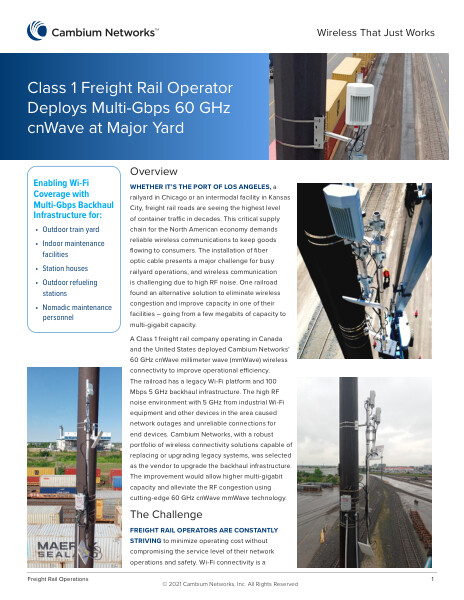Overview
Whether it’s the port of Los Angeles, a railyard in Chicago or an intermodal facility in Kansas City, freight rail roads are seeing the highest level of container traffic in decades. This critical supply chain for the North American economy demands reliable wireless communications to keep goods flowing to consumers. The installation of fiber optic cable presents a major challenge for busy railyard operations, and wireless communication is challenging due to high RF noise. One railroad found an alternative solution to eliminate wireless congestion and improve capacity in one of their facilities – going from a few megabits of capacity to multi-gigabit capacity.
A Class 1 freight rail company operating in Canada and the United States deployed Cambium Networks’ 60 GHz cnWave millimeter wave (mmWave) wireless connectivity to improve operational efficiency. The railroad has a legacy Wi-Fi platform and 100 Mbps 5 GHz backhaul infrastructure. The high RF noise environment with 5 GHz from industrial Wi-Fi equipment and other devices in the area caused network outages and unreliable connections for end devices. Cambium Networks, with a robust portfolio of wireless connectivity solutions capable of replacing or upgrading legacy systems, was selected as the vendor to upgrade the backhaul infrastructure. The improvement would allow higher multi-gigabit capacity and alleviate the RF congestion using cutting-edge 60 GHz cnWave mmWave technology.
The Challenge
Freight rail operators are constantly striving to minimize operating cost without compromising the service level of their network operations and safety. Wi-Fi connectivity is a necessity in the railyards to allow workers to connect from the remote office to their tablets or other handheld devices. Wi-Fi connections are also used to connect locomotives to the corporate network that enables upload of video stored on each locomotive’s local Digital Video Recorder (DVR).
Wi-Fi access points (AP) were mounted to mast light poles throughout the yard. Point-to-point 5 GHz radios were used to provide the bandwidth injection to the Wi-Fi APs. With the increasing number of connected Wi-Fi devices in the yard along with the neighboring Wi-Fi devices from industrial users, the high RF noise started to become a challenge to maintain clean channels and reliable communication.
The railroad evaluated several backhaul options including fiber, licensed microwave and cellular technology. 60 GHz cnWave from Cambium Networks was selected for its combination of multiGbps speed, low sub-millisecond latency and highly reliable distributed mesh topology. 60 GHz carries no spectrum license costs, and the solution could be deployed more quickly, cost effectively and with less disruption compared to trenching new fiber.
Why Rail Operators Choose Cambium Networks’ 60 GHz cnWave
Solutions:
- Multiple-gigabit speed leveraging a distributed mesh topology for resiliency and sub-millisecond latency.
- Affordable, quality solutions that fit business objectives and keep total cost of ownership low.
- Centralized, cloud-managed controller for easy management and monitoring of the entire network.
- Simple network and RF design planning with LINKPlanner.
The Solution
The railroad’s network deployment, as deployed and operational today, features 75 60 GHz cnWave nodes throughout the railyard facility covering an area of just over two miles long and .25 miles wide. Most of the nodes deployed in the network are cnWave V5000 distribution nodes (DN) which enable mmWave distributed mesh networking technology. Other endpoints are connected with the cnWave V1000 client node (CN). Installation was fast with the use of electronic beam-steering, which makes alignment accurate and efficient. All devices are centrally managed by the cnMaestro™ end-to-end cloud-based network controller
The Results
THE cnWave deployment significantly improved the quality of service for the backhaul infrastructure, while eliminating the interference issues with the Wi-Fi APs co-located throughout the yard.
The railroad will continue to upgrade their facilities with cnWave and leverage the cuttingedge mesh capabilities with embedded Terragraph technology to deploy reliable point-topoint, point-to-multipoint and mesh networks in the railyards and intermodal facilities. With the new wireless multi-gigabit capacity available, the railroad has additional ethernet capacity to operate high-resolution video surveillance cameras throughout the yard. This will allow the railroad to monitor the safety of personnel in the yard and provide an additional layer of physical security.
